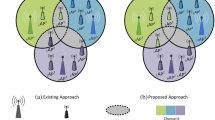Abstract
With the rapid improvement of wireless networking technologies, current mobile devices can be potentially equipped with multiple interfaces to access different kinds of wireless networks. Thus, there have been many efforts to provide a seamless roaming between heterogeneous networks. However, most previous studies do not address how to select the best possible interface in terms of energy consumption. Therefore, in this paper, we propose to take advantage of accurate location positioning via WWAN interface, so that Mobile Nodes (MNs) obtain the information of hotspot range and completely turn off WLAN interface during idle state, leading to save energy consumption. Simulation results show that our mechanism outperforms existing approaches in terms of energy consumption and signaling overhead.
This research was supported by the MIC (Ministry of Information and Communication), Korea, under the ITRC (Information Technology Research Center) support program supervised by the IITA (Institute of Information Technology Advancement) (IITA-2006-C1090-0603-0028).
Preview
Unable to display preview. Download preview PDF.
Similar content being viewed by others
References
McNair, J., Zhu, F.: Vertical Handoffs in Fourth-Generation Multinetwork Environments. IEEE Wireless Communication 11(3), 8–15 (2004)
Guo, C., Guo, Z., Zhang, Q., Zhu, W.: A Seamless and Proactive End-to-End Mobility Solution for Roaming Across Heterogeneous Wireless Networks. IEEE Journal on Selected Areas in Communications 22(5), 834–848 (2004)
Chakravorty, R., Vidales, P., Subramanian, K., Pratt, I., Crowcroft, J.: Performance Issues with Vertical Handovers - Experiences from GPRS Cellular and WLAN Hot-spots Integration. In: Proc. IEEE PerCom, Mar. 2004, pp. 155–164 (2004)
Ylianttila, M., Mäkelä, J., Pahlavan, K.: Analysis of Handoff in a Location-aware Vertical Multi-access Network. Computer Networks 47(2), 185–201 (2005)
Rappaport, T.S., Na, C., Chen, J.K.: Convergence of Cellular and Wireless LAN: Hotspot Traffic Statistics and User Trends. CTIA show, Mar. 22 (2004)
Chary, R., Banginwar, R., Gilbert, J.: Power Management Technologies for WLAN enabled Handheld Devices. In: Intel Developer Forum, Fall (2003)
Shih, E., Bahl, P., Sinclair, M.J.: Wake on Wireless: An Event Driven Energy Saving Strategy for Battery Operated Devices. In: MobiCom, Sep. 2002, pp. 160–171 (2002)
Specification of GPS-9534, http://www.leadtek.com/gps/gps_9534_2.html
3GPP, Technical Specification Group Terminals - Technical realization of the Short Message Service (Release 6), TS 23.040, v6.5.0, http://www.3gpp.org
Yamamoto, R., Matsutani, H., Matsuki, H., Oono, T., Ohtsuka, H.: Position Location Technologies using Signal Strength in Cellular Systems. In: VTC, May 2001, vol. 4, pp. 2570–2574 (2001)
Enhanced UTRAN Extensions for ns-2, http://www.ti-wmc.nl/eurane
The Network Simulator - ns-2, http://www.isi.edu/nsnam/ns
Author information
Authors and Affiliations
Editor information
Rights and permissions
Copyright information
© 2007 Springer Berlin Heidelberg
About this paper
Cite this paper
Seo, S., Lee, S., Song, J. (2007). Location-Aware Signaling Protocol for WWAN and WLAN Interworking. In: Boavida, F., Monteiro, E., Mascolo, S., Koucheryavy, Y. (eds) Wired/Wireless Internet Communications. WWIC 2007. Lecture Notes in Computer Science, vol 4517. Springer, Berlin, Heidelberg. https://doi.org/10.1007/978-3-540-72697-5_23
Download citation
DOI: https://doi.org/10.1007/978-3-540-72697-5_23
Publisher Name: Springer, Berlin, Heidelberg
Print ISBN: 978-3-540-72694-4
Online ISBN: 978-3-540-72697-5
eBook Packages: Computer ScienceComputer Science (R0)




